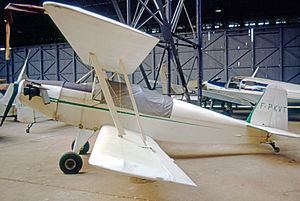Top speed 178 km/h Length 5.6 m Manufacturer Indraéro | Wingspan 7.6 m First flight July 27, 1951 | |
 | ||
The Indraéro Aéro 101 was a light training biplane developed in France in the 1950s.
Contents
Design and service
It was a conventional design with single-bay staggered wings braced with an I-strut, and fixed tailskid undercarriage with divided main units. The pilot and instructor sat in tandem, open cockpits. A small batch of aircraft were ordered by SALS for aeroclub use.
The prototype, known as the Aéro 110, differing from the later production Aero 101s by having a welded steel tube fuselage and a 34 kW (45 hp) Salmson 9ADb radial engine, first flew on 1 May 1950
Operational history
Three examples of the type were current on the French Civil Aircraft Register in 2009, including an Aero 101C and two Aero 101s.
Variants
Specifications (Aéro 101)
Data from
General characteristics
Performance
References
Indraéro Aéro 101 Wikipedia(Text) CC BY-SA
